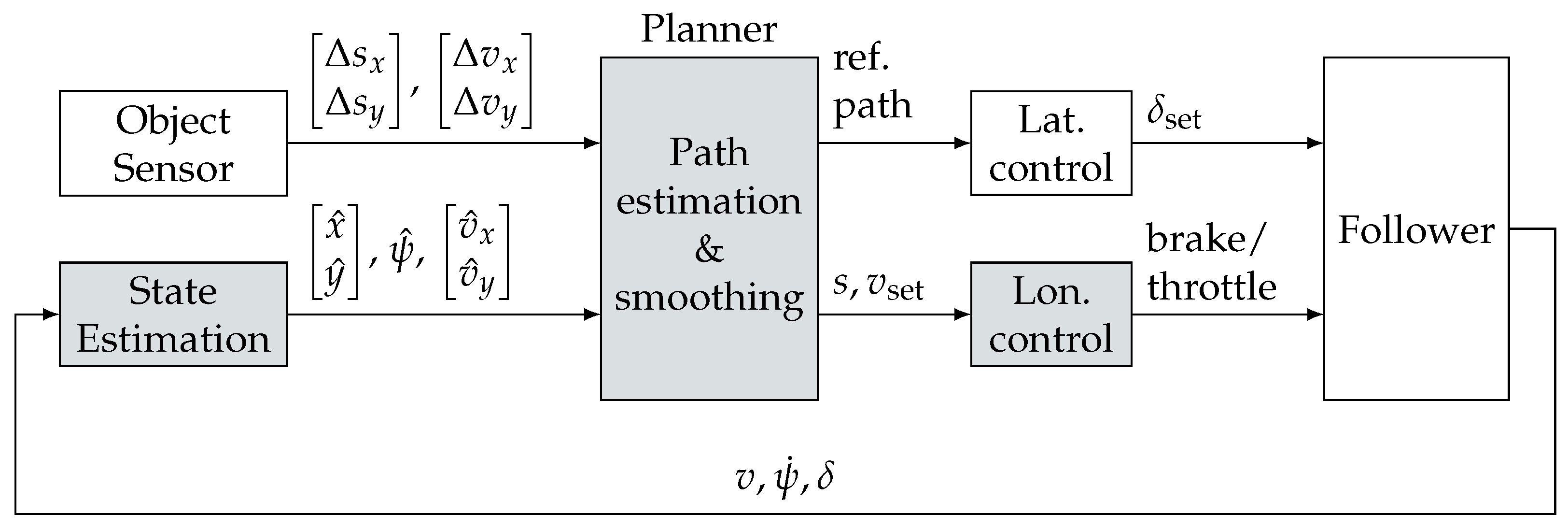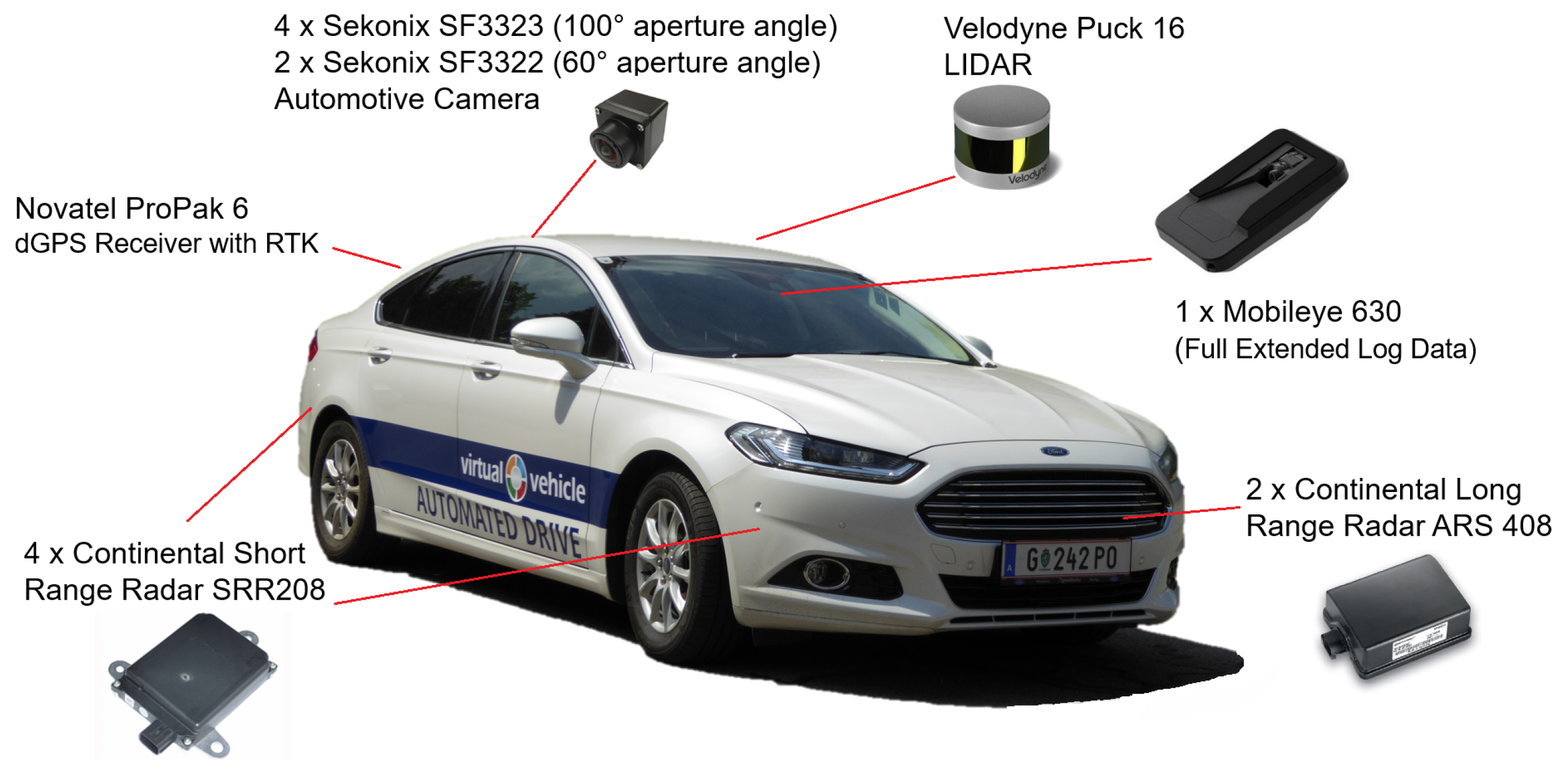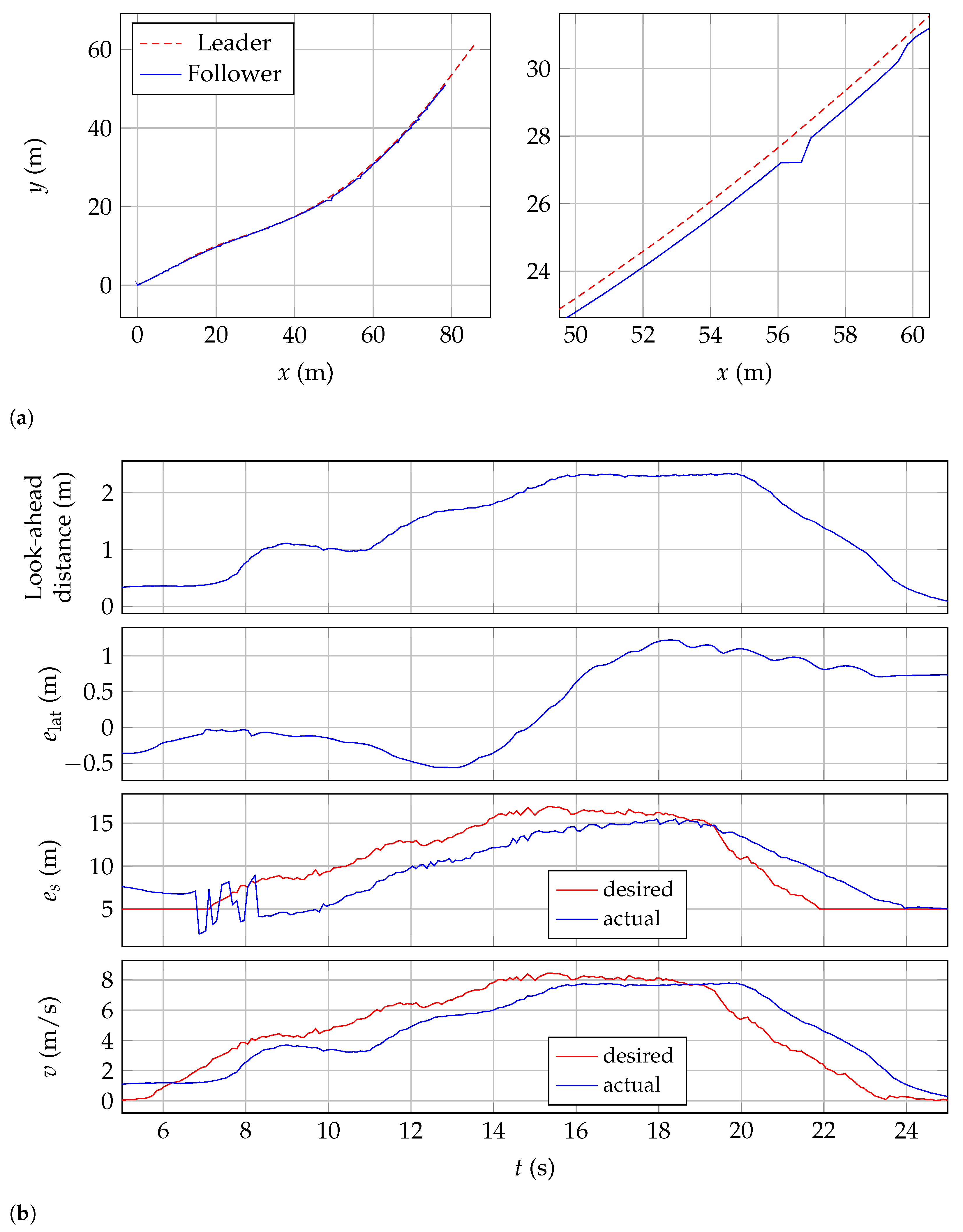Leader-Based Trajectory Following in Unstructured Environments—From Concept to Real-World Implementation
Abstract
:1. Introduction
1.1. Problem Statement
- (R1)
- The vehicle-following system must not rely on vehicle-to-vehicle communication. Consequently, it was decided to only rely on on-board sensors for leader observations as well as follower-state estimation.
- (R2)
- The vehicle-following system must not rely on GPS to avoid narrowing the driving function’s operational-design domain to environments where undisturbed communication to GPS satellites can be guaranteed.
1.2. Literature Review
- A detailed explanation to obtain an estimate of the leader path from the on-board measurements, which are stored in a buffer, is given. To support the process of obtaining and maintaining the stored leader path, a new strategy to consider the importance of each measured sample for the estimated path is proposed (Section 2.1).
- To handle noisy position measurements, we propose smoothing the estimated path resulting from (1) via a computationally inexpensive spline-approximation approach (Section 2.2).
1.3. Structure of the Article
2. System Architecture and Design
2.1. Leader-Path Estimation
- To guarantee the real-time capability of this strategy, the number N of points in the list must not exceed an upper bound , i.e., , where depends on the memory and computing resources of the target hardware.
- New position measurements might not contain relevant information in terms of the estimated path, due to low speed or standstill maneuvers and/or measurement noise. That is, a new point is equal or very close to the most recent point .
2.2. Smoothing the Estimated Path
- Unfortunately, the resulting spline from the spline-approximation algorithm, according to [19], lacks the local support property. That is, a variation of a single data point not only affects the related spline segment but all spline segments, if just a single point of the underlying approximation data changes. Considering that the spline serves as the reference path for the path-tracking controller, as shown in Figure 1, this could result in jumps of the control reference and eventually of the control error every time the spline is updated. Although there are controllers that implement bumpless transfer functionality that could handle steps in the control reference to some extent [22], this is usually not the case; see, for example, the well known Stanley [23] and Pure-Pursuit [24] path-tracking controllers. Therefore, the iterative approach mentioned above was implemented, since it enables the extension of the spline path by a spline segment , while letting the segments be unaffected.
- According to (7), the computational effort mainly depends on the number n of spline segments, considering k and l as fixed. Therefore, the computational effort can be reduced compared to calculating the spline for all points during each iteration, depending on the actual values of and N.
- These improvements are at the cost of only achieving continuous zeroth derivatives at the spline’s breaks. Simulation results showed that requesting higher order continuity at the breaks results in a spline approximation becoming unstable over time. During field tests, this disadvantage turned out to be neglectable.
2.3. Vehicle Control
2.3.1. Lateral Control
2.3.2. Longitudinal Control
3. Test-Vehicle Integration and Field Trials
3.1. Demonstrator Vehicle
3.2. State Estimation
3.3. Leader Selection
3.4. Experimental Results
4. Conclusions and Outlook
Author Contributions
Funding
Acknowledgments
Conflicts of Interest
Abbreviations
| CAN | Controller Area Network |
| DGPS | Differential Global Positioning System |
| GPS | Global Positioning System |
| HD | High Definition |
| LQR | Linear Quadratic Regulator |
| MPC | Model Predictive Control |
| PI | Proportional-Integral |
| SQP | Sequential Quadratic Programming |
| V2V | Vehicle-to-Vehicle |
References
- On-Road Automated Driving (ORAD) Committee. Taxonomy and Definitions for Terms Related to Driving Automation Systems for On-Road Motor Vehicles; Technical Report; SAE International: Warrendale, PA, USA, 2021. [Google Scholar] [CrossRef]
- Zhang, L.; Ahamed, T.; Zhang, Y.; Gao, P.; Takigawa, T. Vision-Based Leader Vehicle Trajectory Tracking for Multiple Agricultural Vehicles. Sensors 2016, 16, 578. [Google Scholar] [CrossRef] [PubMed] [Green Version]
- Gehrig, S.K.; Stein, F.J. A trajectory-based approach for the lateral control of car following systems. SMC’98 Conference Proceedings. In Proceedings of the 1998 IEEE International Conference on Systems, Man, and Cybernetics (Cat. No.98CH36218), San Diego, CA, USA, 14 October 1998; IEEE: Piscataway, NJ, USA, 1998; Volume 4, pp. 3596–3601. [Google Scholar] [CrossRef]
- Daviet, P.; Parent, M. Longitudinal and lateral servoing of vehicles in a platoon. In Proceedings of the Conference on Intelligent Vehicles, Tokyo, Japan, 19–20 September 1996; IEEE: Piscataway, NJ, USA, 1996; pp. 41–46. [Google Scholar] [CrossRef]
- Goi, H.K.; Giesbrecht, J.L.; Barfoot, T.D.; Francis, B.A. Vision-Based Autonomous Convoying with Constant Time Delay. J. Field Robot. 2010, 27, 430–449. [Google Scholar] [CrossRef]
- Goi, H.K.; Barfoot, T.D.; Francis, B.A.; Giesbrecht, J.L. Vision-Based Vehicle Trajectory Following with Constant Time Delay. In Field and Service Robotics; Howard, A., Iagnemma, K., Kelly, A., Eds.; Springer: Berlin/Heidelberg, Germany, 2010; pp. 137–147. [Google Scholar] [CrossRef]
- Shan, M.; Zou, Y.; Guan, M.; Wen, C.; Lim, K.Y.; Ng, C.L.; Tan, P. Probabilistic trajectory estimation based leader following for multi-robot systems. In Proceedings of the 2016 14th International Conference on Control, Automation, Robotics and Vision (ICARCV), Phuket, Thailand, 13–15 November 2016; IEEE: Piscataway, NJ, USA, 2016; pp. 1–6. [Google Scholar] [CrossRef]
- Zou, Y.; Shan, M.; Guan, M.; Wen, C.; Lim, K.Y. A trajectory reconstruction approach for leader-following of multi-robot system. In Proceedings of the 2017 12th IEEE Conference on Industrial Electronics and Applications (ICIEA), Siem Reap, Cambodia, 18–20 June 2017; IEEE: Piscataway, NJ, USA, 2017; pp. 1534–1539. [Google Scholar] [CrossRef]
- Jansen, W.L. Lateral Path-Following Control of Automated Vehicle Platoons. Master’s Thesis, Delft University of Technology, Delft, The Netherlands, 2016. [Google Scholar]
- Fassbender, D.; Heinrich, B.C.; Luettel, T.; Wuensche, H.J. An optimization approach to trajectory generation for autonomous vehicle following. In Proceedings of the 2017 IEEE/RSJ International Conference on Intelligent Robots and Systems (IROS), Vancouver, BC, Canada, 24–28 September 2017. [Google Scholar] [CrossRef]
- Heald, M.A. Rational approximations for the Fresnel integrals. Math. Comput. 1985, 44, 459–461. [Google Scholar] [CrossRef]
- Wei, S.; Zou, Y.; Zhang, X.; Zhang, T.; Li, X. An Integrated Longitudinal and Lateral Vehicle Following Control System With Radar and Vehicle-to-Vehicle Communication. IEEE Trans. Veh. Technol. 2019, 68, 1116–1127. [Google Scholar] [CrossRef]
- Wang, Y.; Bian, N.; Zhang, L.; Chen, H. Coordinated Lateral and Longitudinal Vehicle-Following Control of Connected and Automated Vehicles Considering Nonlinear Dynamics. IEEE Control. Syst. Lett. 2020, 4, 1054–1059. [Google Scholar] [CrossRef]
- Floren, M.; Khajepour, A.; Hashemi, E. An Integrated Control Approach for the Combined Longitudinal and Lateral Vehicle Following Problem. In Proceedings of the 2021 American Control Conference (ACC), New Orleans, LA, USA, 25–28 May 2021; IEEE: Piscataway, NJ, USA, 2021; pp. 436–441. [Google Scholar] [CrossRef]
- Liu, J.; Wang, Z.; Zhang, L. Event-Triggered Vehicle-Following Control for Connected and Automated Vehicles under Nonideal Vehicle-to-Vehicle Communications. In Proceedings of the 2021 IEEE Intelligent Vehicles Symposium (IV), Nagoya, Japan, 11–17 July 2021; IEEE: Piscataway, NJ, USA, 2021; pp. 342–347. [Google Scholar] [CrossRef]
- Schinkel, W.; van der Sande, T.; Nijmeijer, H. State Estimation for Cooperative Lateral Vehicle Following Using Vehicle-to-Vehicle Communication. Electronics 2021, 10, 651. [Google Scholar] [CrossRef]
- Visvalingam, M.; Whyatt, J.D. Line generalisation by repeated elimination of points. Cartogr. J. 1993, 30, 46–51. [Google Scholar] [CrossRef]
- Rumetshofer, J.; Stolz, M.; Watzenig, D. A Generic Interface Enabling Combinations of State-of-the-Art Path Planning and Tracking Algorithms. Electronics 2021, 10, 788. [Google Scholar] [CrossRef]
- Ezhov, N.; Neitzel, F.; Petrovic, S. Spline approximation, Part 1: Basic methodology. J. Appl. Geod. 2018, 12, 139–155. [Google Scholar] [CrossRef]
- Eilers, P.H.C.; Marx, B.D. Flexible smoothing with B-splines and penalties. Stat. Sci. 1996, 11, 89–121. [Google Scholar] [CrossRef]
- Goepp, V.; Bouaziz, O.; Nuel, G. Spline Regression with Automatic Knot Selection. arXiv 2018, arXiv:1808.01770. [Google Scholar]
- Nestlinger, G.; Stolz, M. Bumpless Transfer for Convenient Lateral Car Control Handover. IFAC-PapersOnLine 2016, 49, 132–138, Special Issue: In Proceedings of the 9th IFAC Symposium on Intelligent Autonomous Vehicles IAV 2016, Leipzig, Germany, 29 June–1 July 2016. [Google Scholar] [CrossRef]
- Hoffmann, G.M.; Tomlin, C.J.; Montemerlo, M.; Thrun, S. Autonomous Automobile Trajectory Tracking for Off-Road Driving: Controller Design, Experimental Validation and Racing. In Proceedings of the 2007 American Control Conference, New York, NY, USA, 9–13 July 2007; IEEE: Piscataway, NJ, USA, 2007; pp. 2296–2301. [Google Scholar] [CrossRef]
- Coulter, R.C. Implementation of the Pure Pursuit Path Tracking Algorithm; Technical Report; Camegie Mellon University: Pittsburgh, PA, USA, 1992. [Google Scholar]
- Nestlinger, G. Modellbildung und Simulation Eines Spurhalte-Assistenzsystems. Master’s Thesis, Graz University of Technology, Graz, Austria, 2013. [Google Scholar]
- Solmaz, S.; Nestlinger, G.; Stettinger, G. Compensation of Sensor and Actuator Imperfections for Lane-Keeping Control Using a Kalman Filter Predictor. SAE Int. J. Connect. Autom. Veh. 2021, 4, 8. [Google Scholar] [CrossRef]
- Riekert, P.; Schunck, T. Zur Fahrmechanik des gummibereiften Kraftfahrzeugs. Ingenieur-Archiv 1940, 11, 210–224. [Google Scholar] [CrossRef]
- Hsu, J.C.; Tomizuka, M. Analyses of Vision-based Lateral Control for Automated Highway System. Veh. Syst. Dyn. 1998, 30, 345–373. [Google Scholar] [CrossRef]
- Swaroop, D.; Rajagopal, K. A review of constant time headway policy for automatic vehicle following. In Proceedings of the 2001 IEEE Intelligent Transportation Systems, Oakland, CA, USA, 25–29 August 2001; IEEE: Piscataway, NJ, USA, 2001; pp. 65–69. [Google Scholar] [CrossRef]
- Rajamani, R. Lateral Vehicle Dynamics. In Vehicle Dynamics and Control; Mechanical Engineering Series; Springer: New York, NY, USA, 2012; Chapter 2; pp. 15–46. [Google Scholar] [CrossRef]






| Name | Symbol | Value |
|---|---|---|
| Sample time | 20 | |
| Max. number points | 100 | |
| Area threshold | ||
| Min. clearance | 5 | |
| Time gap | 2 | |
| Look-ahead time | – | 300 |
| Samples per spline segment | 12 | |
| Polynomial degree | k | 3 |
| Geometric continuity | l | 2 |
Publisher’s Note: MDPI stays neutral with regard to jurisdictional claims in published maps and institutional affiliations. |
© 2022 by the authors. Licensee MDPI, Basel, Switzerland. This article is an open access article distributed under the terms and conditions of the Creative Commons Attribution (CC BY) license (https://creativecommons.org/licenses/by/4.0/).
Share and Cite
Nestlinger, G.; Rumetshofer, J.; Solmaz, S. Leader-Based Trajectory Following in Unstructured Environments—From Concept to Real-World Implementation. Electronics 2022, 11, 1866. https://doi.org/10.3390/electronics11121866
Nestlinger G, Rumetshofer J, Solmaz S. Leader-Based Trajectory Following in Unstructured Environments—From Concept to Real-World Implementation. Electronics. 2022; 11(12):1866. https://doi.org/10.3390/electronics11121866
Chicago/Turabian StyleNestlinger, Georg, Johannes Rumetshofer, and Selim Solmaz. 2022. "Leader-Based Trajectory Following in Unstructured Environments—From Concept to Real-World Implementation" Electronics 11, no. 12: 1866. https://doi.org/10.3390/electronics11121866
APA StyleNestlinger, G., Rumetshofer, J., & Solmaz, S. (2022). Leader-Based Trajectory Following in Unstructured Environments—From Concept to Real-World Implementation. Electronics, 11(12), 1866. https://doi.org/10.3390/electronics11121866







